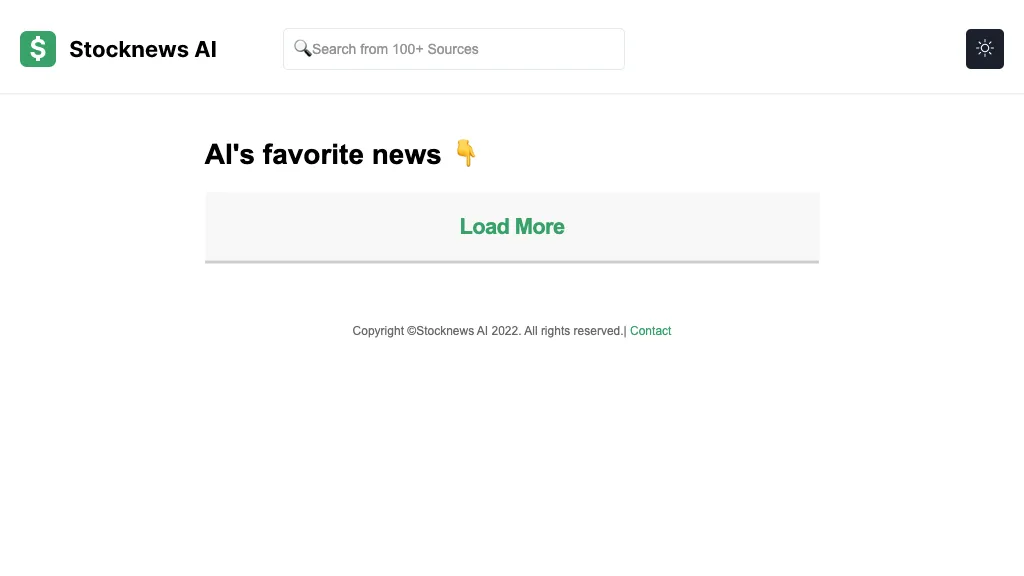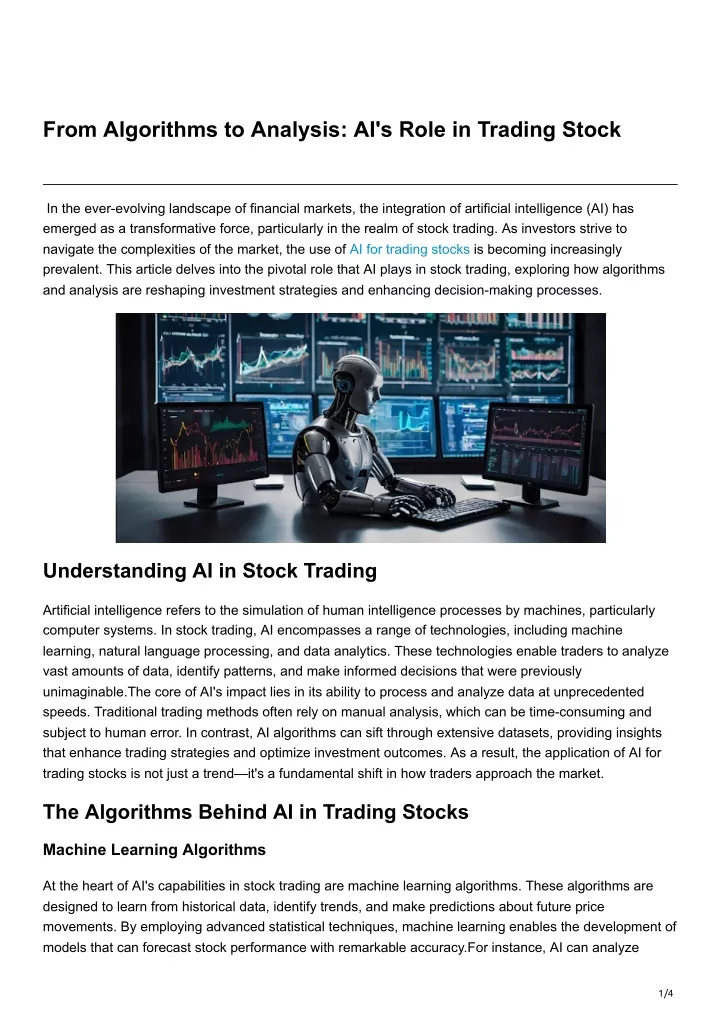AI trading platforms that can predict or analyze stocks are well-known for their ability to tailor strategies to meet the requirements of users. This allows them to adapt to specific trading objectives and conditions, which includes risk tolerance. A platform that offers many customization options can improve your trading performance. Here are 10 suggestions to help you assess the capabilities of a platform to modify your strategy:
1. Evaluate Pre-Built Strategy Templates
The variety of templates available: Find out whether the platform has an array of pre-designed strategies for different trading styles (e.g. day trading, swing trading, long-term investing).
User-friendliness: Consider how easy it is to apply and alter these templates to meet your requirements.
Performance history: See if the platform offers historical performance information on a an already-built strategy.
2. Examine the Custom Strategy Development
Drag-and-drop tools: Find platforms that offer intuitive drag-and-drop interfaces to create custom strategies.
Find out about coding options. For advanced users, it may be necessary to check whether the platform provides custom-made coding.
Flexibility - Ensure that the platform you choose allows you to establish rules for entry and exit, as well as parameters to manage risk, as well as other important components of your strategic plan.
3. Check for Backtesting Capabilities
Data historical: Check whether there is enough records to backtest your strategies.
Customizable parameters - Ensure that you can change parameters (e.g. timeframes, indicator) when back-testing.
Performance metrics: Check whether the platform offers detailed performance metrics (e.g. win rate Sharpe ratio, drawdown) for strategies that have been tested back.
4. Evaluate Real-Time Strategy Testing
Paper trading: Ensure the platform offers paper trading or simulation modes to evaluate strategies in real-time without the risk of losing capital.
Live testing: Test your strategies on live markets by using small amounts of capital to evaluate their performance.
Real-time Adjustments: Determine whether you can adjust in real-time in response to the market's conditions.
5. Integrate Integration and Technical Indicators
Indicator library: See if the platform offers an extensive collection of indicators that are technical (e.g. moving averages, RSI, MACD).
Custom indicators: You should be able to develop or import your own indicators which you can apply to your strategy.
Combination of indicators: Check to see if the platform allows the combination of multiple indicators to create complicated strategies.
6. Check for Risk Management Tools
Stop-loss/take-profit: Ensure the platform allows you to set stop-loss and take-profit levels within your strategies.
Position sizing: Check whether you have the ability to establish position sizing rules (e.g. Fixed amount or percentage of your portfolio) to control risk.
Risk-reward: Find out if your platform permits you to set risk-reward for each strategy or trade.
7. Evaluate Multi-Asset Strategy Support
Asset classes: Make sure the platform is able to help strategies across multiple asset categories (e.g. ETFs, stocks or options, forex).
Strategies for cross-assets: Determine whether you're able to create strategies that take advantage of various asset classes.
Market coverage. Check if the platform has market coverage that you're interested in (e.g. US international, cryptocurrencies).
8. Review the automation, Execution and Execution
Automated trading - Ensure that the platform is capable of automating trading strategies based on the defined rules.
Types of orders: Make sure that the platform can execute different types of orders, such as stop, limit, market and stop.
The Latency Checker: Ensure that the platform permits transactions to be completed with the least amount of latency. This is especially important when it comes to high-frequency strategy.
9. Make sure you are using tools to optimize your strategy.
Optimization of parameters: Make sure the platform has tools for optimizing strategy parameters (e.g. grid search or genetic algorithms).
Machine learning integration Check to see if your platform incorporates machine learning in order to enhance and improve strategies.
Scenario Analysis: Find out whether the platform can test strategies for various markets (e.g. bull or bear or volatile).
Check out the Community Feedback and User Reviews
User feedback: Conduct user research to assess the effectiveness of the platform in creating a custom strategies.
Community forums: Find out whether the platform hosts an active community in which users are able to discuss and discuss customized strategies.
Support resources - Ensure that the platform has tutorials and documentation for users to create and enhance strategies.
Bonus Tips
Trial period: Test the features of the platform that allow customization by using a trial or demo.
Scalability is essential. The platform must be able to handle strategies that get more complicated when your trading expands.
Support for customers: Find out whether the platform offers support on strategy-related issues and concerns.
These tips will help you assess the ability of AI trading platforms to tailor their strategies. You'll be able to choose the best platform for your trading requirements and makes it possible to you to fine-tune and implement your plan. A platform that is robustly customizable features can enable you to adjust to changing market conditions and boost the efficiency of your trading. See the top rated additional info on best ai trading app for website recommendations including stock ai, ai trading tools, ai for stock predictions, chart ai trading assistant, investing ai, ai stock picker, ai chart analysis, market ai, options ai, ai trading and more.

Top 10 Ways To Evaluate The Speed And Latency Of The Ai Analysis And Stock Prediction Platform
For high-frequency, algorithmic, and active traders in particular the area of speed and latencies are key factors when evaluating AI platforms to forecast stock prices and analyze. Even milliseconds in delay can negatively impact profitability and trade execution. Here are ten of the most effective ways to measure the speed and the latency of the platforms.
1. Data feeds that are real-time: How to assess them
Data delivery speed Make sure the platform is able to deliver real-time data (e.g. sub-millisecond delay).
Nearness of the data source: To decrease the time it takes to transmit data, check if your platform's servers can be situated near major exchanges.
Data compression: Examine to see if there are efficient methods of data compression that can increase the speed of delivery of data.
2. Test the speed of execution for trades
Processing orders: The platform's ability to complete and process trades fast once an order has been submitted.
Direct market access: Check whether the exchange allows direct orders to be made to the exchange.
Review the execution reports to determine if they include timestamps of order confirmation, fill, and submission.
3. Review the responsiveness of the Platform
User interface (UI), speed: Test the platform’s response time to your inputs.
Updates to charts - Check that your charts are up-to-date in real time and without lag.
Performance of mobile apps. When using mobile apps, you should ensure it's running as fast and smoothly as a desktop version.
4. Look for infrastructure that is not low-latency.
Servers' locations The platform must use high-speed, low-latency servers which are situated near major exchanges or financial hubs.
Co-location: If the exchange allows co-location, then you can place your trading algorithm on servers near the exchange.
High-speed networks: Verify that the platform is using fiber-optic high-speed networks or any other low-latency methods.
5. Check the backtesting speed and simulation speed.
Historical data processing: See how quickly your platform analyzes and processes historical data.
Platform latency must be minimal enough to permit live simulations of trades in real time.
Parallel processing: Make sure the system is running parallel processing or distributed computing, which speeds the process of complex calculations.
6. Assess API Latency
API response time determining how quickly the platform's API responds (e.g. fetching market data or placing orders).
Rate limits: Determine whether the API has reasonable rate limits to avoid delay during high-frequency trading.
WebSocket support Find out if your device is running WebSocket protocol for low-latency real-time streaming of data.
7. Test the stability of the platform under load
Create scenarios for high-volume trading to determine whether the platform is reliable and stable.
Test your platform in times of high market volatility.
Test your strategies for stress: See whether the platform provides tools for stress testing your strategies under extreme circumstances.
8. Review Connectivity and Network
Internet speed demands. Ensure that your internet connection meets minimum speeds recommended for your platform to ensure the best performance.
Reliable connections: Check that your platform is equipped with redundant internet connections. This will allow you to avoid downtime.
VPN latency. Check if you're using the VPN to determine if it causes latency.
9. Look for features that speed up your speed.
Pre-trade analyses: The platform should provide pre-trade analysis to help optimize speed of execution and routing of orders.
Smart order routing (SOR), also known as smart order routing is a method of determining the fastest and the most cost effective execution venues.
Check the platform's tools to monitor and analyse latency in real-time.
Review Benchmarks and User Feedback
User reviews: Research feedback from users to evaluate the platform's speed and performance.
Third-party benchmarks by third parties. Look for independent benchmarks or reviews that evaluate a platform's speed with other platforms.
Case studies: Check whether the platform has cases studies or testimonials that demonstrate the low-latency capabilities.
Bonus Tips
Trial period: You can avail a demo for free or a trial to test out the performance and latency of the platform.
Customer Support: Make sure that the platform can offer support in latency-related problems or for optimization.
Hardware requirements: Determine whether the platform requires special hardware (e.g., high-performance PCs) to operate at its maximum speed.
Utilizing these guidelines using these tips, you will be able to accurately assess the speed, latency, and precision of AI software for analyzing and predicting stocks. This allows you to select a system based on your trading requirements as well as reducing any delays. The importance of low latency is particularly important for high-frequency and algorithmic traders, since even tiny delays can have a significant impact on profits. Follow the best learn more on best ai stocks to buy now for more advice including free ai stock picker, ai share trading, best stock prediction website, can ai predict stock market, ai stock predictions, can ai predict stock market, how to use ai for stock trading, how to use ai for copyright trading, best ai stock prediction, ai stock prediction and more.
